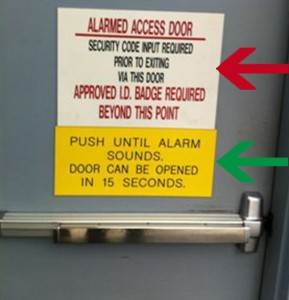Hardware must be meticulously specified and maintained in order to perform as intended in the event of an emergency. However, often times, people compromise properly configured egress systems by adding in convenience features designed for more frequent non-emergency usage. The IBC requires exit signs, directional signs, and “NO Exit” signs to provide occupants with sufficient information in order to quickly exit a building in the event of an emergency.
Can you identify what is right and what is wrong with this delayed egress door?
- Right: The sign stating ‘PUSH UNTIL ALARM SOUNDS. DOOR CAN BE OPENED IN 15 SECONDS.”
- This is required by IBC 1008.1.9.7 and is appropriately applied because of the use of delayed egress hardware on this opening.
- Wrong: The second sign, advising that a security code must be entered.
- This could cause a person to leave the area in search of an alternate exit during a fire or similar emergency situation rather than attempting to open this door.
The section of code is outlined here in its entirety:
IBC – 1008.1.9.7
Approved, listed, delayed egress locks shall be permitted to be installed on doors serving any occupancy except Groups Assembly, Education and High-Hazard occupancies in buildings that are equipped with an automatic sprinkler system or an approved automatic smoke or heat detection system.
- A building occupant shall not be required to pass through more than one door equipped with a delayed egress lock before entering an exit.
- Doors unlock upon actuation of the automatic sprinkler system or automatic fire detection system
- Doors unlock upon loss of power controlling the lock or lock mechanism
- Door locks shall have the capability of being unlocked by a signal from the fire command center
- A delayed egress lock will prevent egress for 15 seconds (or 30 seconds when approved by the AHJ) when initiated by a 15-pound force
- Initiation shall activate an audible signal in the vicinity of the door
- Once the door has been released relocking shall be by manual means only
- A sign shall be provided on the door located above and within 12” of the release device reading: PUSH UNTIL ALARM SOUNDS. DOOR CAN BE OPENED IN 15 [30] SECONDS.
- Emergency lighting shall be provided at the door
Still have questions? Use the comment section below.
If you have a hard time understanding the required standards, don’t feel bad, you’re neither the first nor the last to be confused by them. LockNet employs multiple AHC’s and an EHC in training; we’re always willing to evaluate hardware specifications or explain code requirements.
Source: ICC Safe, NFPA Today
Google


The portion of the NFPA 101®, Life Safety Code® that applies to emergency lighting, exit signs, and “means of egress” is presented below (from the 2012 edition). The NFPA 101,® Life Safety Code® is a “model code,” and while some states or localities have implemented the code in full, other states or locality have implemented only certain parts and changed others. For the most accurate information on your local codes, check with your local code enforcement agency.
Call me wind because I am ablesutoly blown away.
I have exactly what info I want. Check, please. Wait, it’s free? Awmeose!
After exiting through one delayed egress into another room; can that room have additional delayed egress doors. So if there is 4 doors, does only one have to be without a delayed egress or must they all be without a delayed egress? (you can’have more than one delayed egress in an exit pathway)